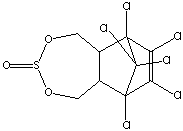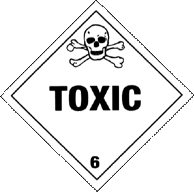Endosulfan
- Thiosulfan
- (1,4,5,6,7,7-Hexachloro-8,9,10-trinorborn-5-en-2,3-ylenebismethylene)sulfite
- 6,9-Methano-2,4,3-benzodioxathiepin, 6,7,8,9,10,10-hexachloro-1,5,5a,6,9,9a-Hexahydro-, 3-oxide

Endosulfan | |
| |
| Formula | C9H6Cl6O3S |
| Structure |  |
| Description | A brown or colorless crystalline solid with a pungent odor. Shipped in suspension in a liquid carrier. A mixture of isomers of a sulfurous acid ester of a hexachlorinated cyclic diol. |
| Uses | Non-systemic insecticide and acaricide. |
| Registry Numbers and Inventories. | |
| CAS | 115-29-7 |
| EC (EINECS/ELINCS) | 204-079-4 |
| EC Index Number | 602-052-00-5 |
| EC Class | Toxic; Irritant; Dangerous for the Environment |
| RTECS | RB9275000 |
| RTECS class | Agricultural Chemical and Pesticide; Tumorigen; Mutagen; Reproductive Effector; Human Data |
| UN (DOT) | 2761 |
| Merck | 12,3614 |
| Beilstein/Gmelin | 8188565 |
| RCRA | P050 |
| EPA OPP | 79401 |
| Swiss Giftliste 1 | G-1610 |
| Austrailia AICS | Listed |
| New Zealand | Listed |
| Properties. | |
| Formula | C9H6Cl6O3S |
| Formula mass | 406.93 |
| Melting point, °C | 70 |
| Boiling point, °C | 106 (0.7 torr) |
| Vapor pressure, mmHg | 6E-6 |
| Vapor density (air=1) | 14.0 |
| Density | 1.745 g/cm3 (20 C) |
| Solubility in water | 0.1 mg/L |
| Partition coefficient, pKow | 3.83 |
| Hazards and Protection. | |
| Storage | Tightly closed containers. Keep away from heat and water in a well ventilated area. Do not store thiodan miscible at temperatures below 20 degrees F. |
| Handling | All chemicals should be considered hazardous. Avoid direct physical contact. Use appropriate, approved safety equipment. Untrained individuals should not handle this chemical or its container. Handling should occur in a chemical fume hood. |
| Protection | Wear appropriate chemical protective clothing. |
| Respirators | Wear positive pressure self-contained breathing apparatus. |
| Small spills/leaks | Keep sparks, flames, and other sources of ignition away. Keep material out of water sources and sewers. Build dikes to contain flow as necessary. Attempt to stop leak if without undue personnel hazard. Use water spray to knock-down vapors. Land spill: Dig a pit, pond, lagoon, holding area to contain liquid or solid material. Dike surface flow using soil, sand bags, foamed polyurethane, or foamed concrete. Absorb bulk liquid with fly ash or cement powder. Water spill: If dissolved, in region of 10 ppm or greater concentration, apply activated carbon at ten times the spilled amount. Use mechanical dredges or lifts to remove immobilized masses of pollutants and precipitates. |
| Stability | Nonexplosive. |
| Incompatibilities | Incompatible with strong oxidizing and reducing agents Incompatible with many amines, nitrides, azo/diazo compounds, alkali metals, and epoxides. |
| Decomposition | When heated to decomposition it emits toxic fumes of cl- and sulfoxides. |
| Fire. | ||||
| Fire fighting | Extinguish fire using agent suitable for type of surrounding fire. (Material itself does not burn or burns with difficulty.) Use foam, dry chemical, or carbon dioxide. Cool all affected containers with flooding quantities of water. Apply water from as far a distance as possible. Keep run-off water out of sewers and water sources. | |||
| Fire potential | Flammable in xylene solution, technical endosulfan nonflammable. | |||
| Hazards | Container may explode in heat of fire. Fire or run off from fire control water may release irritating or poisonous gases. Slowly oxidizes in air. Do not store at temperature below 20F. | |||
| Combustion products | Fire may produce irritating, corrosive and/or toxic gases. | |||
| Health. | |
| Exposure limit(s) | TLV: 0.1 mg/m3 (as TWA), A4 (skin) (ACGIH 1997). NIOSH REL: TWA 0.1 mg/m3 skin |
| Poison_Class | 2 |
| Exposure effects | Respiratory depression, fever, apnea, and cyanosis may occur. Elevated body temperature and recurrent abnormally low blood pressure occurred in related poisoning. The nervous system is the primary target of acute toxicity. Syncope may be the earliest sign of endosulfan toxicity. Sensory disturbances, excitation with myoclonic jerking, convulsions, tremor, ataxia, agitation, nervousness, and amnesia may occur. Permanent damage may occur from acute exposure to endosulfan. Endosulfan has been fetotoxic and induced musculoskeletal defects in rats. Effects on testes and sperm were seen in rats. |
| Ingestion | Nausea, vomiting, and diarrhea frequently occur following ingestion. |
| Inhalation | Dyspnea along with apnea and cyanosis may occur. Irritation, reduced gas exchange, and chemical pneumonitis may also occur. |
| Skin | Extensive contact results in dermal irritation. Endosulfan is rapidly absorbed through the skin. |
| Eyes | Hypersalivation, frothing from the mouth and nose, and headache may occur. |
First aid |
|
| Ingestion | Seek medical assistance. |
| Inhalation | Move victim to fresh air. Apply artificial respiration if victim is not breathing. Do not use mouth-to-mouth method if victim ingested or inhaled the substance; induce artificial respiration with the aid of a pocket mask equipped with a one-way valve or other proper respiratory medical device. Administer oxygen if breathing is difficult. |
| Skin | Remove and isolate contaminated clothing and shoes. Remove material from skin immediately. Immediately flush with running water for at least 20 minutes. For minor skin contact, avoid spreading material on unaffected skin. |
| Eyes | Irrigate exposed eyes with copious amounts of tepid water for at least 15 minutes. If irritation, pain, swelling, lacrimation, or photophobia persist, the patient should be seen in a health care facility. |
| Transport. | ||
| UN number | 2761 |  |
| Response guide | 151 | |
| Hazard class | 6.1 | |
| Packing Group | I; II; III | |
| USCG CHRIS Code | ESF | |
| Std. Transport # | 4921516 | |